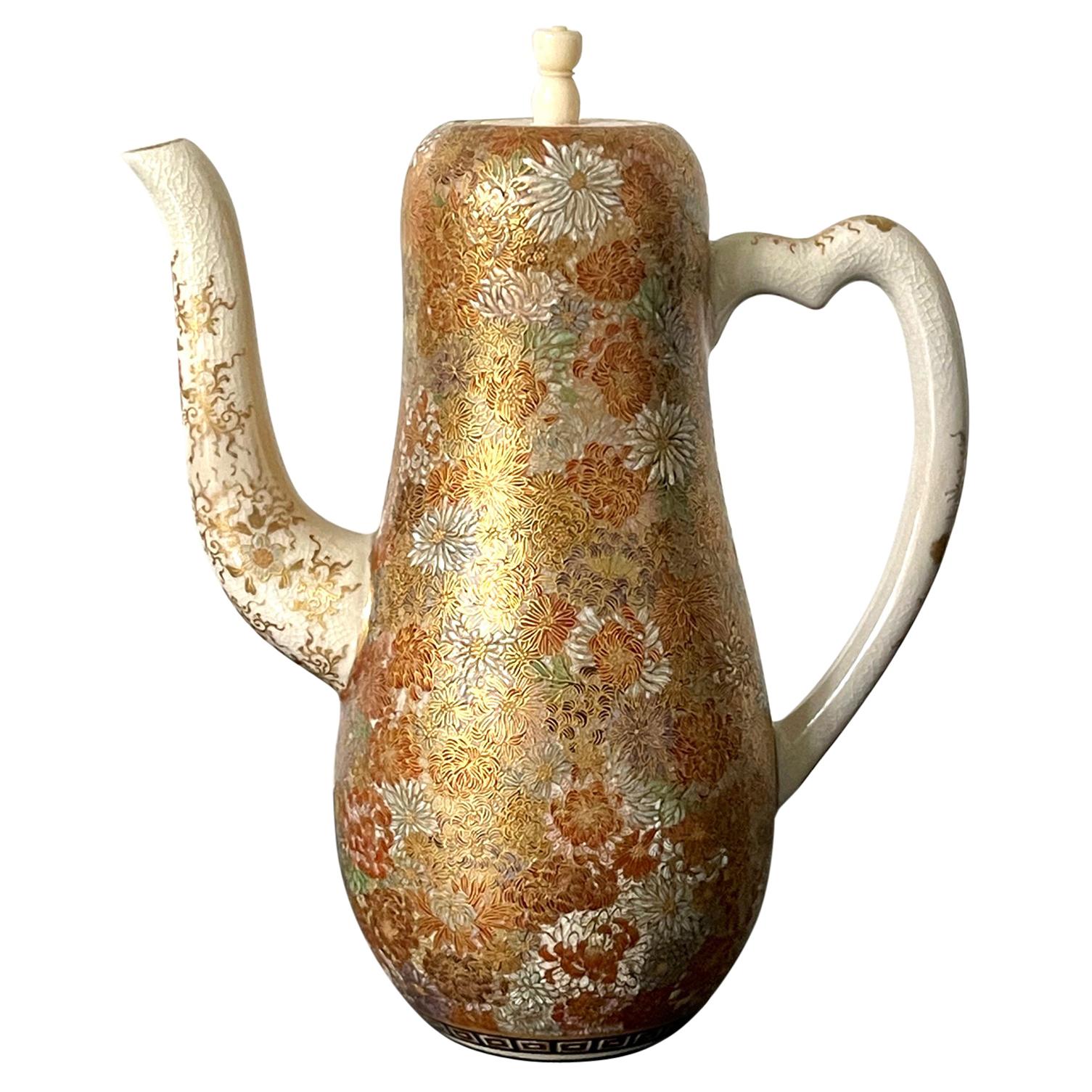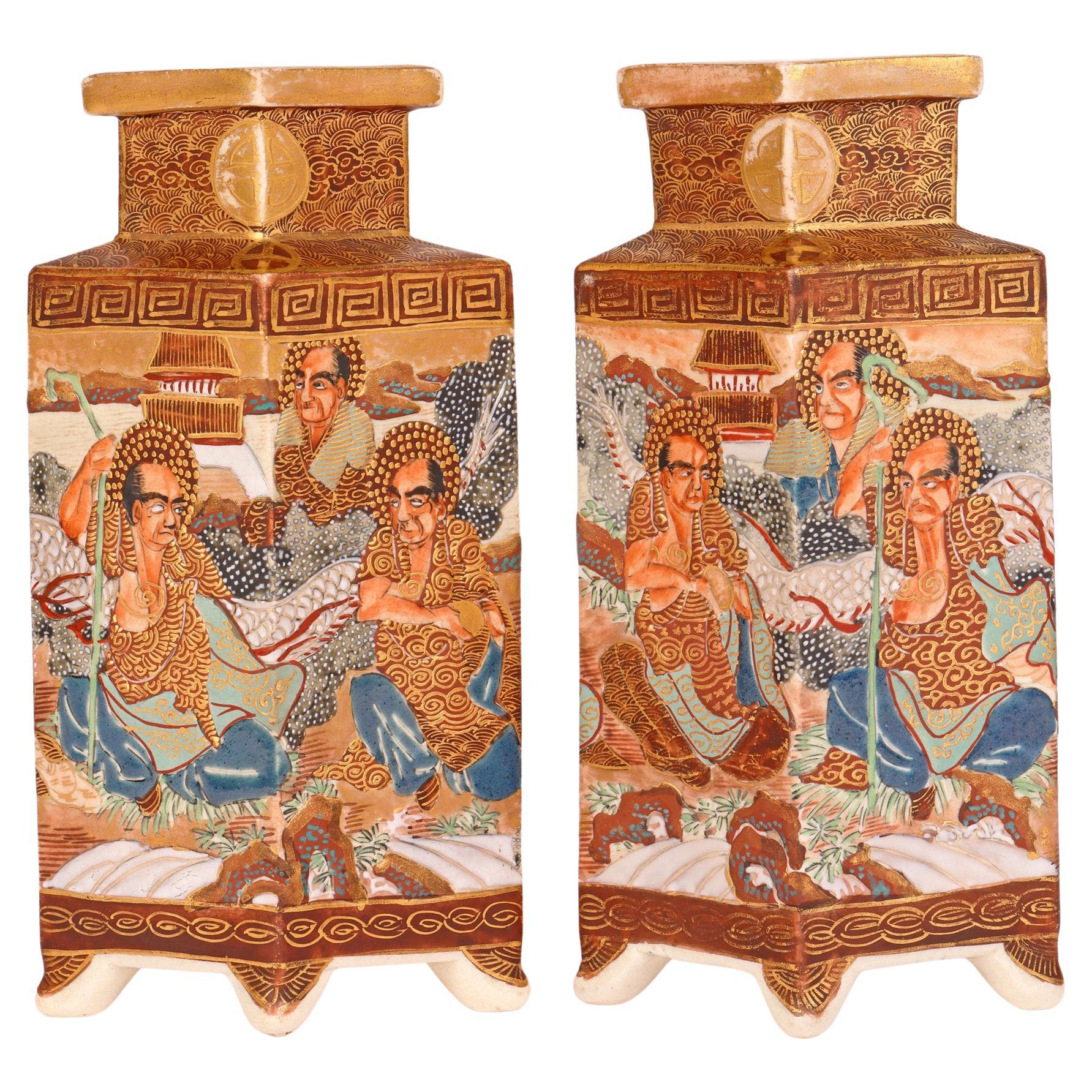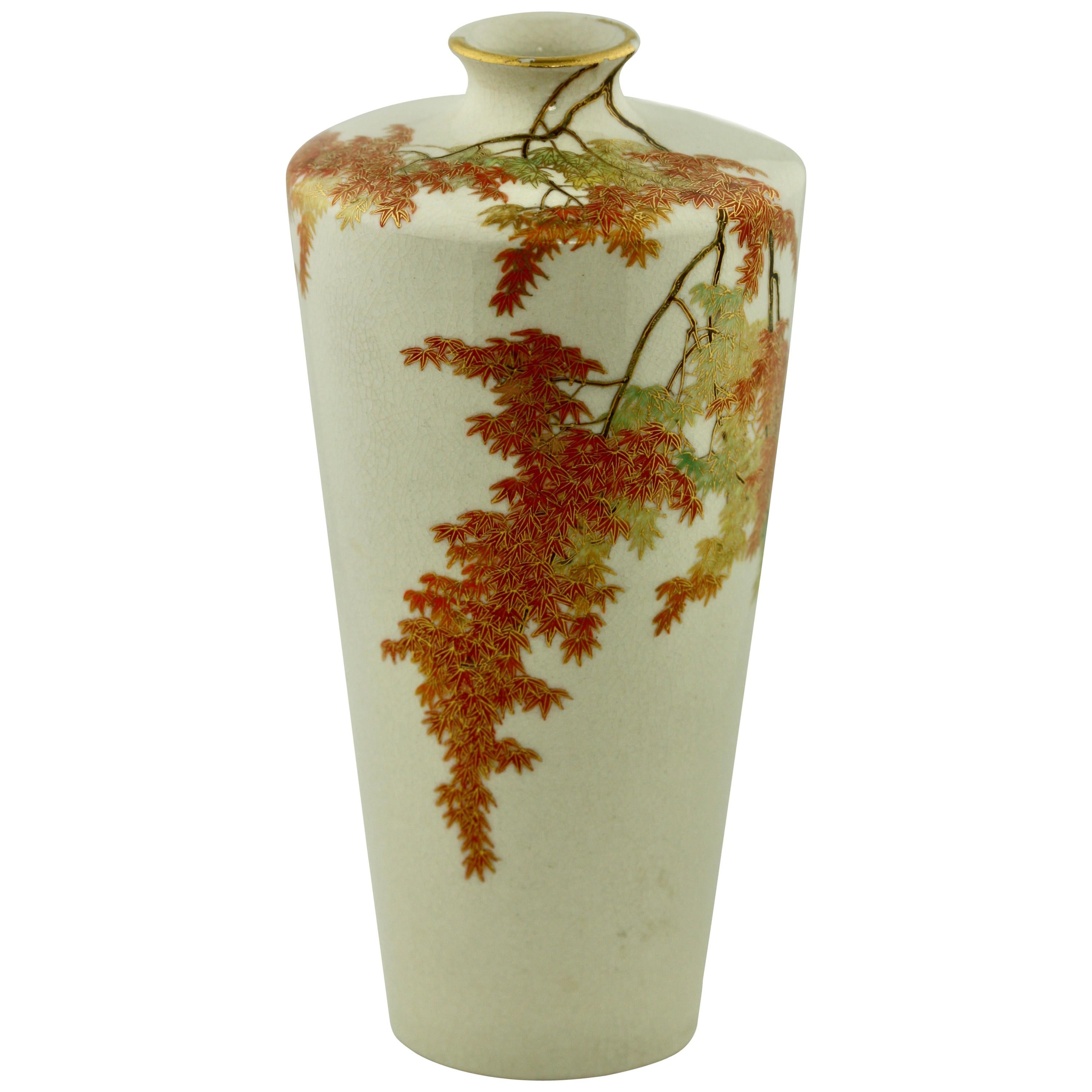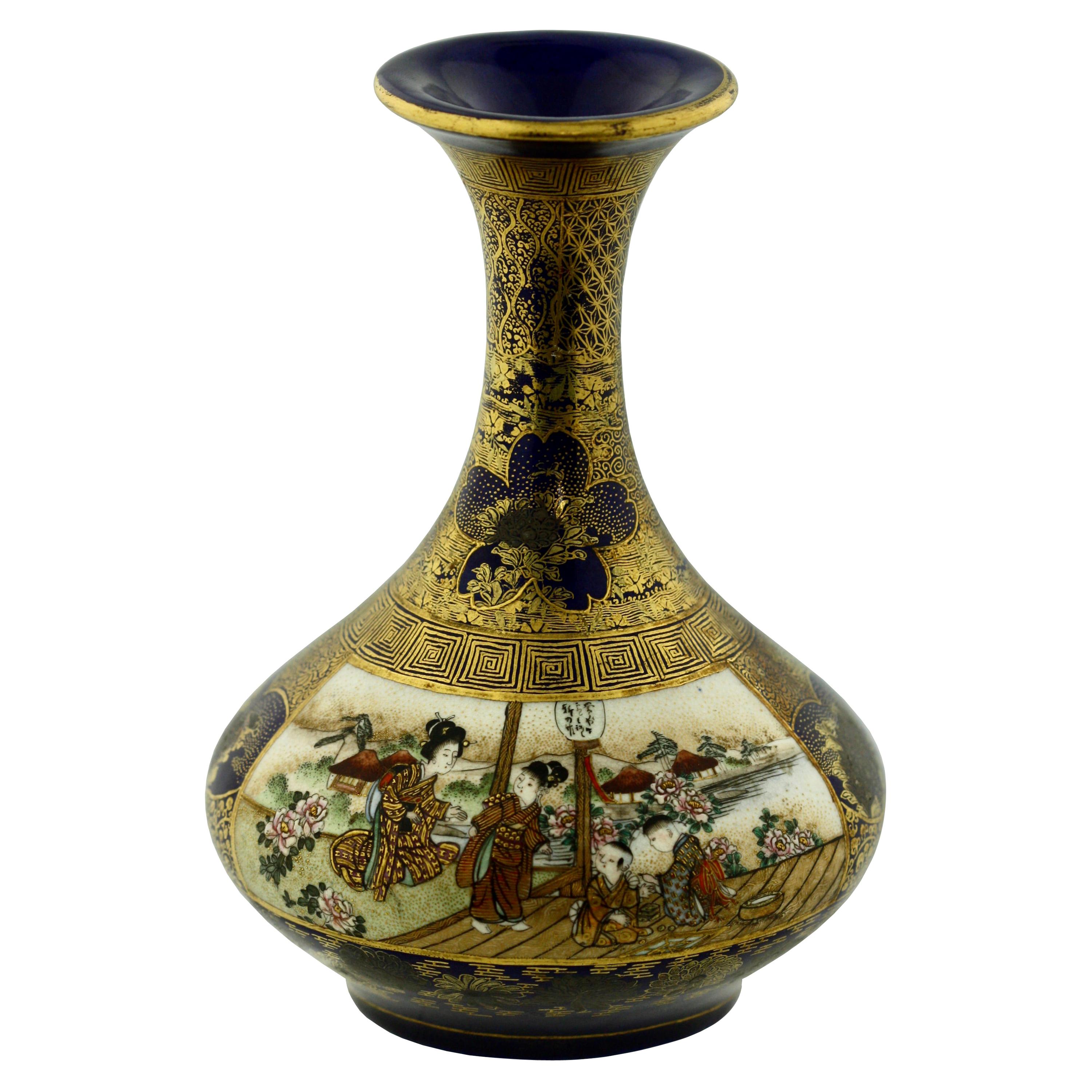Items Similar to Japanese Satsuma Vase Yabu Meizan Meiji
Want more images or videos?
Request additional images or videos from the seller
1 of 17
Japanese Satsuma Vase Yabu Meizan Meiji
About the Item
A Satsuma baluster form vase from the studio of Yabu Meizan (birth name Yabu Masashichi; 1853-1934), who is one of the most celebrated and collectible Satsuma artists from Meiji Period. From his studio in Osaka, Yabu Meizan oversaw the production of the finest Satsuma wares for both domestic and export markets. He participated many international exposes at the turn of the 20th century and won numerous awards for his creation.
This vase is relatively large by Yabu Meizan standard, and the composition indicates that it was made during his later period when he no longer favored extremely dense design, but more nature-oriented still life scene instead of human activities. The exterior of the vase was beautifully draped with maple branches in the fall season. Shimmering leaves in shades of red and gold are literally turning colors in front of the viewer's eyes. Two small birds perched among the leaves, half hidden, waiting for the discovery by the curious. The composition is poetic along the tradition of the ink painting that is stylized to focus on the ambience. The refined and extremely detailed painting contrasts beautifully with the empty spaces intentional left. More is more and less is more, both are true perhaps on this piece?
The base is marked with the golden seal of Yabu Meizan.
- Creator:Yabu Meizan (Artist)
- Dimensions:Height: 9.25 in (23.5 cm)Diameter: 4 in (10.16 cm)
- Style:Meiji (Of the Period)
- Materials and Techniques:Ceramic,Glazed
- Place of Origin:
- Period:
- Date of Manufacture:1910s
- Condition:Wear consistent with age and use. Fine condition with some rubbing off the gilt on the mouth rim as shown. Shelf wear on the base.
- Seller Location:Atlanta, GA
- Reference Number:1stDibs: LU945031371152
About the Seller
5.0
Platinum Seller
These expertly vetted sellers are 1stDibs' most experienced sellers and are rated highest by our customers.
Established in 2006
1stDibs seller since 2010
479 sales on 1stDibs
Typical response time: <1 hour
- ShippingRetrieving quote...Ships From: Atlanta, GA
- Return PolicyA return for this item may be initiated within 2 days of delivery.
More From This SellerView All
- Japanese Miniature Satsuma Vase Yabu Meizan MeijiBy Yabu MeizanLocated in Atlanta, GAA small Satsuma vase from the studio of Yabu Meizan (birth name Yabu Masashichi; 1853-1934), who is one of the most celebrated and collectible Satsu...Category
Antique Early 1900s Japanese Meiji Ceramics
MaterialsCeramic
- Japanese Satsuma Ceramic Ewer Yabu MeizanBy Yabu MeizanLocated in Atlanta, GAA Satsuma ware miniature ewer from the studio of Yabu Meizan (birth name Yabu Masashichi; 1853-1934), who was one of the most celebrated and collectible Satsuma artists from the Meij...Category
Early 20th Century Japanese Japonisme Ceramics
MaterialsCeramic
- Large Japanese Satsuma Ceramic Vase KinkozanBy KinkozanLocated in Atlanta, GAA large Japanese ceramic vase from the end of Meiji period circa 1890-1910s by Kinkozan (1645-1927). One of the largest studio manufacturers of the export ceramics at the time based in Kyoto. In the typical style of satsuma made at the turn of 20th century, the vase is elaborately decorated with a rather unusual kinran-de (gold paint) and green enamel highlight on a mottled brown background. The painterly decoration depicts a large seasonal floral arrangement in a circular fashion. Besides the obviously superb craftsmanship, what sets this particular vase apart from many lower quality and mass-produced pieces is its tone-on-tone color pallet that is visually somber and the small and sensitive details that heralds the change of the seasons. When the viewer goes beyond the first casual glimpse of the blossom and foliage, one would notice that on the edges of certain leaves as well as along the stalks, there accumulates a very thin layer of the white dust that represents the frost. The flower in bloom are chrysanthemums. Despite of being splendid, they are the messengers of the autumn. The large lotus leaf was subtly rendered in a bended and slightly withered manner, just past its prime. Although the lotus is still in bloom, the prominent seed pod indicates it may be the last for the season. The sentimental capture of the change of the seasons is not unusual in Japanese art. This vase poetically represents such a subtle transition from summer to fall, perhaps depicting the very first frost. The neck of the vase is also slightly unusual with two rolled rings...Category
Early 20th Century Japanese Meiji Ceramics
MaterialsCeramic
- Exquisite Japanese Satsuma Vase by SeikozanLocated in Atlanta, GAA miniature vase in elegant upright form reminiscent of the Chinese imperial Willow Leaf form made by Japanese studio Seikozan circa 1890-1910s (late Meiji Period). One of the many a...Category
Antique 1880s Japanese Meiji Ceramics
MaterialsCeramic
- Fine Japanese Ceramic Satsuma Vase by KinkozanBy KinkozanLocated in Atlanta, GAA miniature Japanese ceramic vase from the end of Meiji period circa 1880s- 1910s by Kinkozan (1645-1927). One of the largest studio manufacturers of the export ceramics at the time ...Category
Early 20th Century Japanese Meiji Ceramics
MaterialsCeramic
- Early Japanese Satsuma Antique VaseBy SatsumaLocated in Atlanta, GAAn Satsuma ceramic stone ware vase, circa 19th century, around the end of the Edo and the beginning of Meiji period. In the form of a Classic garlic bottle whose prototype was from China, the white bodied piece is decorated with an early form of kin nishikide, the so called golden brocade, a palette of iron-red, blue, green, yellow, purple and black with golden highlight. The over glazed enamel paint shows a group of robed figures in a garden setting with a lion and three tigers. A transparent overall glaze shows very fine crackles. The design is relatively sparse with plenty of negative space in contrast to the Satsuma production from the late 19th century, when the trend became fussy and overly glitz, due to the influence by the perceived western taste for the export market. This piece may still be made for export but its pattern was more influenced by both Kyoto Pottery and the Kano school of painting compared to the export ware by the end of the 19th century onward to the early 20th century. It was believed by many that this was a result of Satsuma potters visiting Kyoto in the late seventeenth century to learn over glaze painting techniques. There are some age glaze crackles especially around the foot. The piece is not signed in keeping with the earlier production before Satsuma ceramics...Category
Antique Mid-19th Century Japanese Japonisme Ceramics
MaterialsCeramic
You May Also Like
- Satsuma Japanese Meiji Pair Diamond Shaped Pottery VasesBy SatsumaLocated in Bishop's Stortford, HertfordshireA good and unusual pair antique Japanese Satsuma Meiji diamond shaped pottery vases decorated with monk figures with a scrolling dragon dating from the 1...Category
Antique 19th Century Japanese Meiji Ceramics
MaterialsPottery
- Satsuma Tapering Cylindrical Square High-Shouldered Vase by Yabu MeizanBy Yabu MeizanLocated in West Palm Beach, FLA Satsuma tapering cylindrical square high-shouldered vase by Yabu Meizan, Osaka, 1853-1934, decorated in polychrome enamels and gilt over a clear, cr...Category
Antique 1850s Vases
MaterialsEnamel
- Japanese Satsuma Vases, PairBy SatsumaLocated in New York, NYA gorgeous pair of Japanese earthenware Satsuma vases, hand-painted, Meiji period, circa early-20th century, Japan. Vases' beautiful decoration is high-qu...Category
Early 20th Century Japanese Meiji Ceramics
MaterialsEarthenware
- Satsuma Earthenware Vase, by Kinkozan, Japanese, Meiji PeriodBy SatsumaLocated in West Palm Beach, FLA Satsuma Earthenware Vase, by Kinkozan, Japanese, Meiji period (1868-1912) decorated in polychrome enamels and gilt over a clear, crackled glaze, delicately painted with ladies and men, the reverse with a flowering garden with sprays of flowers, the neck with geometric and floral designs, a band of kifu heads in silver and gilt above the foot, on a midnight-blue ground, signed Kinkozan zo...Category
Antique 1860s Vases
MaterialsEarthenware
- Japanese Meiji Satsuma Vase in Lacquered Porcelain with Golden Fish MotifLocated in New York, NYJapanese Meiji period Satsuma vase in lacquered porcelain with decorative gold fish and red coral motif. The piece was made in circa 1900 and has marks on the bottom. In great vintag...Category
Antique Early 1900s Japanese Meiji Ceramics
MaterialsPorcelain
- Japanese Meiji Satsuma Polygonal VaseBy Kyoto PotteryLocated in Gainesville, FLJapanese Meiji Satsuma polygonal vase with four panels. Each panel shows a different scene. Fine gilding and hand enameling. Marked on the bottom with shimadzu mon.Category
Antique Late 19th Century Asian Meiji Ceramics
MaterialsPottery
Recently Viewed
View AllMore Ways To Browse
Ceramics From Japan
Japanese Market
Japanese Late Meiji
Japanese Golden
Japan Made Ceramic
Japanese Seal
Antique Glaze Colors
Small Japanese Ceramics
Asian Vase Gold
Japanese Studio Ceramics
Meiji Red
Japanese Satsuma
Satsuma Japan
Satsuma Antique
Antique Satsuma
Antique Japanese Seals
Antique Japanese Satsuma
Golden Maple





